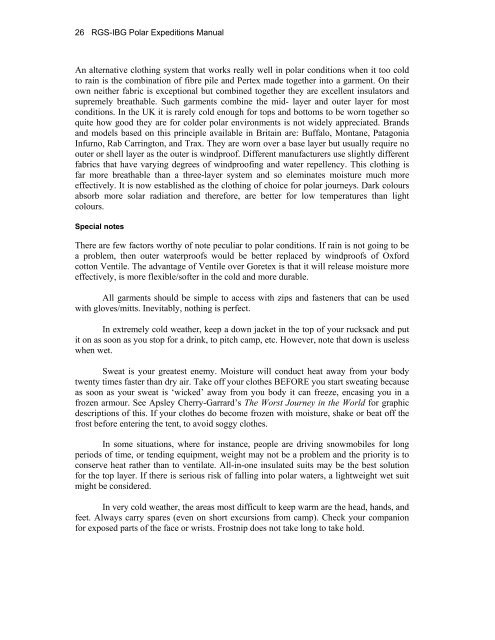Edited by Rachel Duncan 4th Edition ISBN 0-907649-91-2 London ...
Edited by Rachel Duncan 4th Edition ISBN 0-907649-91-2 London ...
Edited by Rachel Duncan 4th Edition ISBN 0-907649-91-2 London ...
You also want an ePaper? Increase the reach of your titles
YUMPU automatically turns print PDFs into web optimized ePapers that Google loves.
26 RGS-IBG Polar Expeditions Manual<br />
An alternative clothing system that works really well in polar conditions when it too cold<br />
to rain is the combination of fibre pile and Pertex made together into a garment. On their<br />
own neither fabric is exceptional but combined together they are excellent insulators and<br />
supremely breathable. Such garments combine the mid- layer and outer layer for most<br />
conditions. In the UK it is rarely cold enough for tops and bottoms to be worn together so<br />
quite how good they are for colder polar environments is not widely appreciated. Brands<br />
and models based on this principle available in Britain are: Buffalo, Montane, Patagonia<br />
Infurno, Rab Carrington, and Trax. They are worn over a base layer but usually require no<br />
outer or shell layer as the outer is windproof. Different manufacturers use slightly different<br />
fabrics that have varying degrees of windproofing and water repellency. This clothing is<br />
far more breathable than a three-layer system and so eleminates moisture much more<br />
effectively. It is now established as the clothing of choice for polar journeys. Dark colours<br />
absorb more solar radiation and therefore, are better for low temperatures than light<br />
colours.<br />
Special notes<br />
There are few factors worthy of note peculiar to polar conditions. If rain is not going to be<br />
a problem, then outer waterproofs would be better replaced <strong>by</strong> windproofs of Oxford<br />
cotton Ventile. The advantage of Ventile over Goretex is that it will release moisture more<br />
effectively, is more flexible/softer in the cold and more durable.<br />
All garments should be simple to access with zips and fasteners that can be used<br />
with gloves/mitts. Inevitably, nothing is perfect.<br />
In extremely cold weather, keep a down jacket in the top of your rucksack and put<br />
it on as soon as you stop for a drink, to pitch camp, etc. However, note that down is useless<br />
when wet.<br />
Sweat is your greatest enemy. Moisture will conduct heat away from your body<br />
twenty times faster than dry air. Take off your clothes BEFORE you start sweating because<br />
as soon as your sweat is ‘wicked’ away from you body it can freeze, encasing you in a<br />
frozen armour. See Apsley Cherry-Garrard’s The Worst Journey in the World for graphic<br />
descriptions of this. If your clothes do become frozen with moisture, shake or beat off the<br />
frost before entering the tent, to avoid soggy clothes.<br />
In some situations, where for instance, people are driving snowmobiles for long<br />
periods of time, or tending equipment, weight may not be a problem and the priority is to<br />
conserve heat rather than to ventilate. All-in-one insulated suits may be the best solution<br />
for the top layer. If there is serious risk of falling into polar waters, a lightweight wet suit<br />
might be considered.<br />
In very cold weather, the areas most difficult to keep warm are the head, hands, and<br />
feet. Always carry spares (even on short excursions from camp). Check your companion<br />
for exposed parts of the face or wrists. Frostnip does not take long to take hold.

















